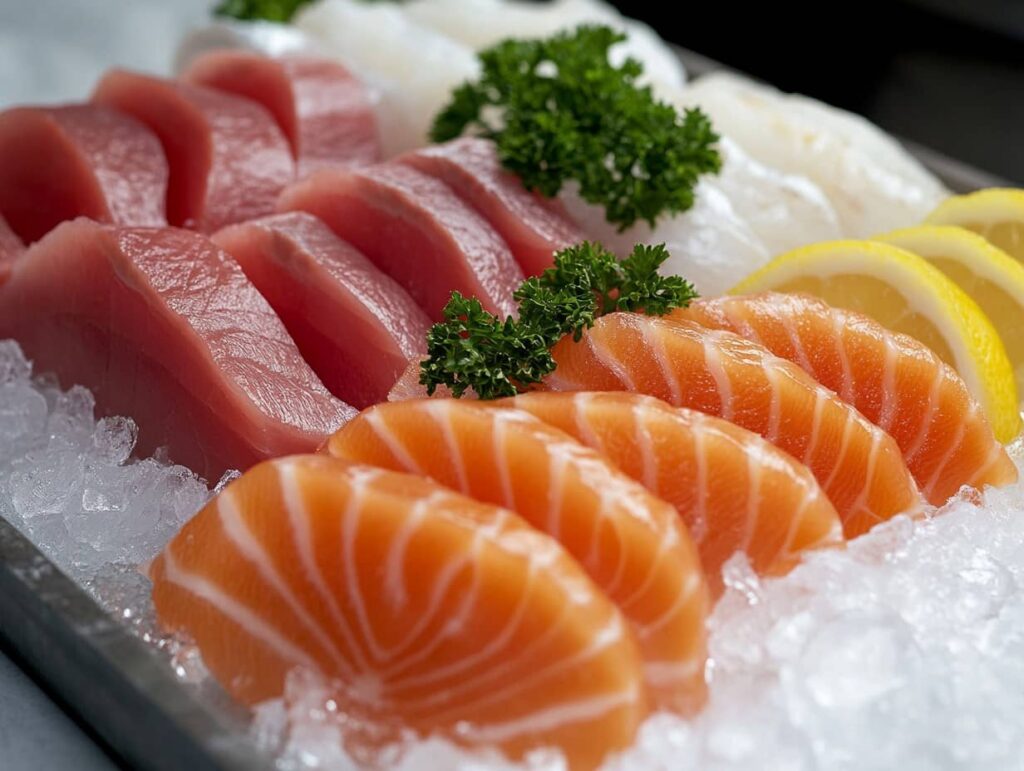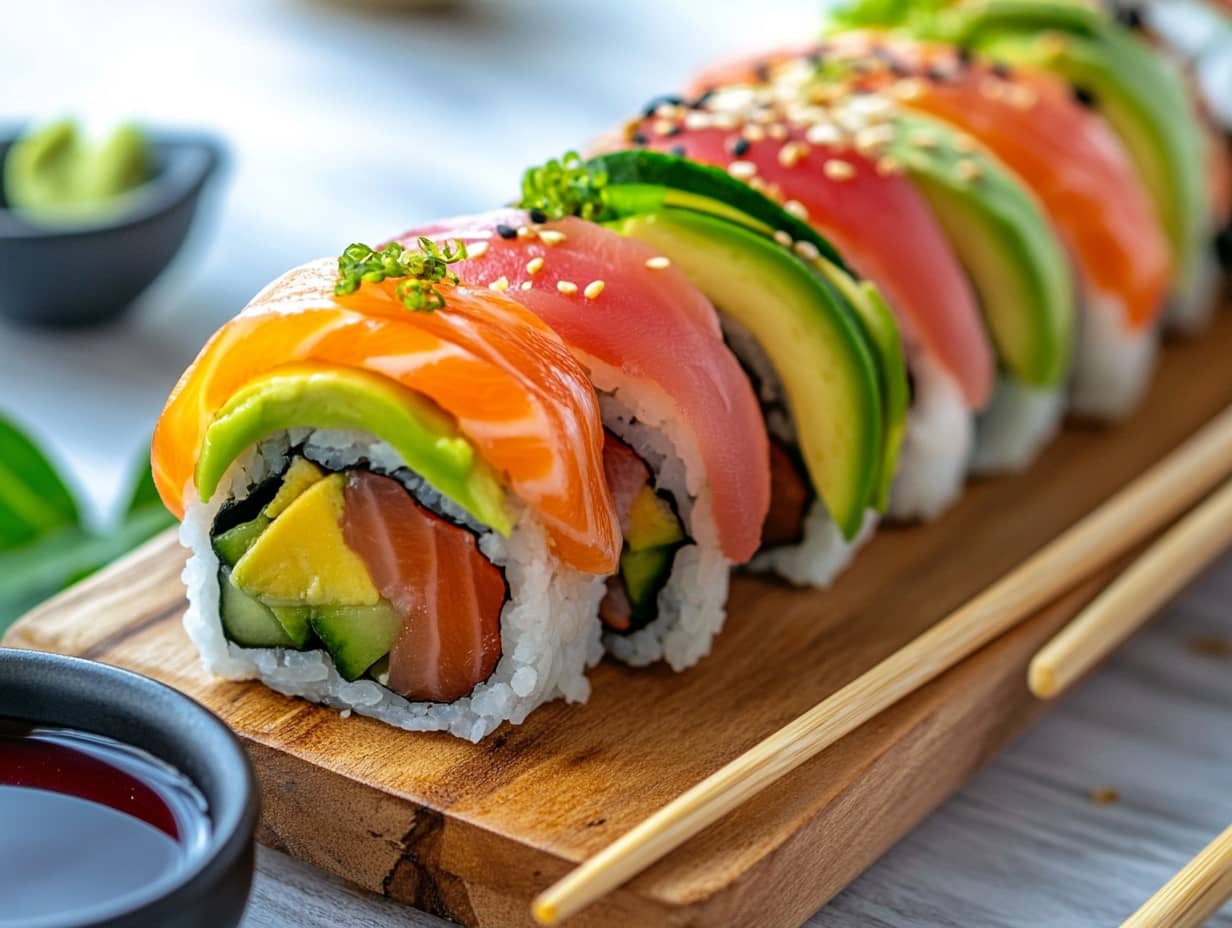When it comes to sushi, rainbow rolls are one of the most colorful and appealing options on the menu. But let’s pause for a second are these rolls as healthy as they look? Whether you’re a sushi lover or just curious about making better dietary choices, this guide dives deep into everything you need to know about rainbow rolls. Spoiler alert: there’s a lot more to it than meets the eye!
Table of Contents
What Is a Rainbow Roll? Understanding Its Ingredients
To figure out if rainbow rolls are healthy, we first need to understand what they’re made of. Think of a rainbow roll as a sushi masterpiece vibrant, layered, and packed with flavor. Each component plays a significant role in its nutritional profile.
The Components of a Rainbow Roll: Fish, Rice, and Vegetables
At its core, the rainbow roll combines:
- Sushi Rice: This is the foundation of the roll, seasoned with vinegar and sugar for that slightly tangy taste.
- Seaweed (Nori): A thin sheet that holds everything together.
- Assorted Fish: Usually includes slices of salmon, tuna, and white fish.
- Vegetables: Think creamy avocado, crisp cucumber, and other fresh veggies.
- Optional Toppings: Sesame seeds, spicy mayo, or even tobiko (fish roe) for added crunch and flavor.
Each ingredient contributes not only to the taste but also to the roll’s overall health profile. But don’t be fooled by its beauty some elements might not be as innocent as they seem.
“A rainbow roll is like a small universe wrapped in seaweed bursting with flavors, textures, and, yes, nutritional surprises.”
Nutritional Breakdown of Common Fish in Rainbow Rolls
Fish is the star of the show in a rainbow roll, and it’s where a lot of the health benefits come from. Let’s break it down:

- Salmon: Rich in omega-3 fatty acids, which are great for heart health. It’s also loaded with vitamin D and protein.
- Tuna: A lean source of protein and vitamin B12. However, some types of tuna may have higher mercury levels.
- White Fish (e.g., Snapper): Low in fat but still a good source of protein.
Check out this recipe on cooking salmon bites for more omega-3-rich meal ideas.
The Role of Rice in Sushi: White vs. Brown Rice Options
White rice is the go-to for sushi, but it’s not the only choice. White rice is soft and slightly sweet but lacks the fiber and nutrients of brown rice. On the other hand, brown rice has more fiber, which can help with digestion and keeping you full longer. Learn about alternative sushi bases in this comparison between rainbow rolls and dragon rolls.
So, should you switch to brown rice? It’s a healthier option, but it might change the texture of your sushi.
Adding Veggies: Avocado, Cucumber, and Their Nutritional Value
Vegetables in rainbow rolls are a total win. Avocado provides healthy fats that are good for your heart, while cucumber adds hydration and crunch without piling on the calories.
The balance of veggies and fish in a rainbow roll makes it an appealing option for those seeking both flavor and health benefits. For more colorful sushi ideas, explore rainbow roll toppings that will blow your mind.
Health Benefits of Eating Rainbow Rolls
Now that you know what’s inside a rainbow roll, let’s talk about the good stuff its health benefits. Sure, it’s tasty, but it can also be a surprisingly nutritious addition to your diet when eaten in moderation.
Omega-3 Fatty Acids in Fish: Boosting Heart Health
Fish like salmon and tuna are swimming with omega-3 fatty acids. These healthy fats can reduce inflammation, improve brain function, and support your heart by lowering bad cholesterol levels. Plus, they’re a natural mood booster so eating sushi can actually make you happier!
Vitamins and Minerals in Vegetables: Enhancing Immunity
Vegetables like cucumber and avocado are nutrient powerhouses. Avocados are packed with potassium, which can help manage blood pressure, and cucumbers are loaded with antioxidants that can boost your immune system.
Protein Content: Building Blocks for Muscles and Energy
Rainbow rolls are a great source of protein, thanks to the fish and sometimes the rice. Protein is essential for repairing tissues, building muscles, and keeping you energized throughout the day.
“Every bite of a rainbow roll isn’t just delicious it’s a small step toward a healthier you.” 🐟🍣
Potential Health Concerns with Rainbow Rolls
As delicious as rainbow rolls are, it’s not all sunshine and rainbows. They come with a few potential downsides, especially if you’re eating them often or without paying attention to portion sizes. Let’s dive into some common health concerns and how you can navigate them.
Mercury Levels in Fish: What You Need to Know
Fish is a fantastic source of nutrients, but some types like tuna can contain higher levels of mercury. Over time, consuming too much mercury can affect your nervous system. Does this mean you should skip rainbow rolls altogether? Not necessarily.
Here’s the key: moderation. The occasional rainbow roll is unlikely to push you over safe mercury limits, but if you’re eating sushi multiple times a week, it might be worth considering fish with lower mercury levels like salmon or snapper. For a healthier alternative, consider trying steelhead trout recipes which offer similar health benefits with lower mercury risk.
“Mercury in fish can be a hidden villain, but knowing your fish helps you enjoy sushi without stress.” 🐟
Calories and Carbohydrates in Sushi Rice
Sushi rice is seasoned with vinegar and sugar, making it slightly sweet and tangy but also higher in calories than plain rice. A typical rainbow roll can have anywhere from 300 to 400 calories, and most of it comes from the rice.
If you’re watching your carb intake or trying to lose weight, this can add up quickly. Opt for smaller portions, or look for rolls made with less rice or even cucumber-wrapped alternatives.
Sodium Content in Soy Sauce and Sushi Preparations
Love drizzling soy sauce on your sushi? You’re not alone! But here’s the thing soy sauce is notoriously high in sodium. Just one tablespoon can contain nearly 40% of your recommended daily sodium intake.
High sodium levels can lead to bloating, increased blood pressure, and other health issues over time. To make your meal healthier, choose low-sodium soy sauce or try alternative dips like ponzu or wasabi for flavor without the salt overload.
Customizing Rainbow Rolls for a Healthier Diet
The beauty of rainbow rolls is their versatility. You can tweak the ingredients to suit your health goals without sacrificing taste. Let’s explore some easy ways to make rainbow rolls even better for you.
Opting for Low-Sodium Soy Sauce or Alternatives
Soy sauce is a sushi staple, but as we mentioned, it’s not the healthiest option. Low-sodium soy sauce can reduce your sodium intake significantly. Want to skip soy sauce entirely? Try a squeeze of fresh lemon or a splash of tamari, a gluten-free soy sauce alternative.
Choosing Whole-Grain or Low-Carb Rice Options
Substituting white rice with brown rice in your rainbow roll adds fiber and nutrients while lowering its glycemic index. You can also try cauliflower rice for a low-carb alternative that still pairs beautifully with sushi ingredients.
Adding or Substituting Vegetables for Extra Nutrients
Why not amp up the veggie content? Add extra cucumber, carrots, or even bell peppers for a nutrient boost. If you’re feeling adventurous, swap the fish for plant-based proteins like tofu to create a vegetarian rainbow roll.
“Sushi isn’t just food; it’s a canvas where you can paint your health goals.” 🥑🎨
Comparing Rainbow Rolls to Other Sushi Types
Not all sushi is created equal. If you’re wondering how rainbow rolls stack up against other popular sushi options, let’s break it down.
Is Rainbow Roll Healthier Than Spicy Tuna or California Rolls?
Rainbow rolls are often seen as a healthier option compared to spicy tuna rolls. Why? Spicy tuna rolls usually include mayo-based sauces, which are high in calories and fat. California rolls, on the other hand, are less nutrient-dense since they don’t include a variety of fish.
Sashimi vs. Rainbow Roll: Which Is Better for Health?
Sashimi, which is just slices of raw fish, skips the rice altogether. This makes it a lower-carb, high-protein option. However, it also lacks the fiber and additional nutrients that the vegetables in a rainbow roll provide. The choice depends on your dietary goals!
Vegetarian Sushi Options vs. Rainbow Rolls
Vegetarian sushi, like avocado rolls, can be lower in calories and higher in fiber but lacks the omega-3 fatty acids and protein you get from fish in a rainbow roll. It’s a trade-off, but both options can fit into a healthy diet.
Rainbow Roll and Dietary Preferences
Rainbow rolls are as versatile as they are colorful, making them a great fit for various dietary preferences. Whether you’re aiming to lose weight, go gluten-free, or stick to a plant-based diet, there’s a way to make rainbow rolls work for you.
Are Rainbow Rolls Suitable for Weight Loss?
If you’re trying to shed some pounds, you might wonder if rainbow rolls can fit into your plan. Here’s the deal: they’re not inherently a “diet food,” but they can be part of a balanced, calorie-conscious meal.
The key is portion control. A standard rainbow roll has about 300–400 calories, which isn’t bad, but adding multiple rolls, soy sauce, or other sides like tempura can quickly add up. Stick to one roll and pair it with a side salad or miso soup to keep the meal light but satisfying.
“Weight loss doesn’t mean giving up sushi it’s about eating smart and savoring every bite.” 🥗🍣
How to Make Gluten-Free or Keto-Friendly Versions
If you’re avoiding gluten, be cautious of ingredients like soy sauce and imitation crab, which often contain wheat. Swap traditional soy sauce for tamari and opt for real crab or fish instead of imitation versions.
For a keto-friendly option, ditch the rice entirely! Cucumber-wrapped sushi is a fantastic alternative that keeps the carbs low while maintaining that sushi flavor and crunch. See how homemade rainbow rolls can fit into your dietary preferences.
Vegan Alternatives to Rainbow Rolls
For plant-based eaters, creating a vegan rainbow roll is easier than you’d think. Replace the fish with marinated tofu, mushrooms, or even slices of roasted sweet potato. Load up on colorful veggies like carrots, avocado, and cucumber to mimic the “rainbow” effect. For more plant-based inspiration, explore vegan appetizer recipes.
“A vegan rainbow roll is proof that sushi can be delicious, creative, and cruelty-free.” 🌱✨
Tips for Making Healthier Rainbow Rolls at Home
Making sushi at home might sound intimidating, but trust me, it’s not as hard as it seems. Plus, it gives you full control over the ingredients, so you can create a healthier version tailored to your preferences.
Choosing the Freshest Fish and Sustainable Seafood
Fresh fish isn’t just tastier it’s also safer. Look for fish with a mild smell, firm texture, and bright color. Bonus points if you can find sustainably sourced seafood, which is better for the planet and your conscience.
Check your local seafood market or trusted grocery store for high-quality options. If you’re unsure about what to buy, ask the staff they’re usually happy to help.
Reducing Calories with Creative Ingredient Swaps
Want to keep your rolls light? Here are some simple swaps:
- Use cauliflower rice instead of sushi rice for a low-carb twist.
- Substitute Greek yogurt for mayo in sauces to cut down on fat.
- Add extra veggies like spinach or bell peppers for more nutrients with fewer calories.
Simple Recipes for DIY Rainbow Rolls
Here’s a basic step-by-step guide for making rainbow rolls at home:
- Prepare Your Ingredients: Slice your fish, avocado, and cucumber thinly. Cook your sushi rice (or cauliflower rice) and season it with a little rice vinegar.
- Lay It Out: Place a sheet of nori on a bamboo sushi mat. Spread the rice over it in a thin layer.
- Add Fillings: Place cucumber and avocado in the center.
- Roll It Up: Use the mat to roll everything tightly.
- Top with Fish: Arrange slices of fish and avocado on top to create the “rainbow.”
- Slice and Serve: Use a sharp knife to cut into bite-sized pieces. Serve with low-sodium soy sauce or your favorite dip.
“Making sushi at home turns your kitchen into a sushi bar minus the hefty bill!” 🍣🎉
Frequently Asked Questions About Rainbow Rolls
Got more questions? Let’s tackle some of the most common ones people have about rainbow rolls.
Are Rainbow Rolls Safe During Pregnancy?
While rainbow rolls are delicious, they’re not recommended for pregnant people due to the raw fish. Instead, opt for fully cooked or vegetarian rolls to satisfy your sushi cravings safely.
How Many Calories Are in a Typical Rainbow Roll?
On average, a rainbow roll contains 300–400 calories. The exact number depends on portion sizes, ingredients, and any added sauces or toppings.
Can Rainbow Rolls Be Part of a Balanced Diet?
Absolutely! With a mix of protein, healthy fats, and carbs, rainbow rolls can be a well-rounded meal. Just be mindful of portion sizes and sodium intake.
Conclusion: Is Rainbow Roll Healthy for You?
So, is the rainbow roll healthy? The answer is: it depends. When eaten in moderation, it can be a nutritious and delicious option. It’s packed with omega-3s, vitamins, and protein, but be cautious of its sodium, calorie, and mercury content. With a few smart tweaks, you can make rainbow rolls even healthier so go ahead, enjoy this sushi favorite guilt-free!

